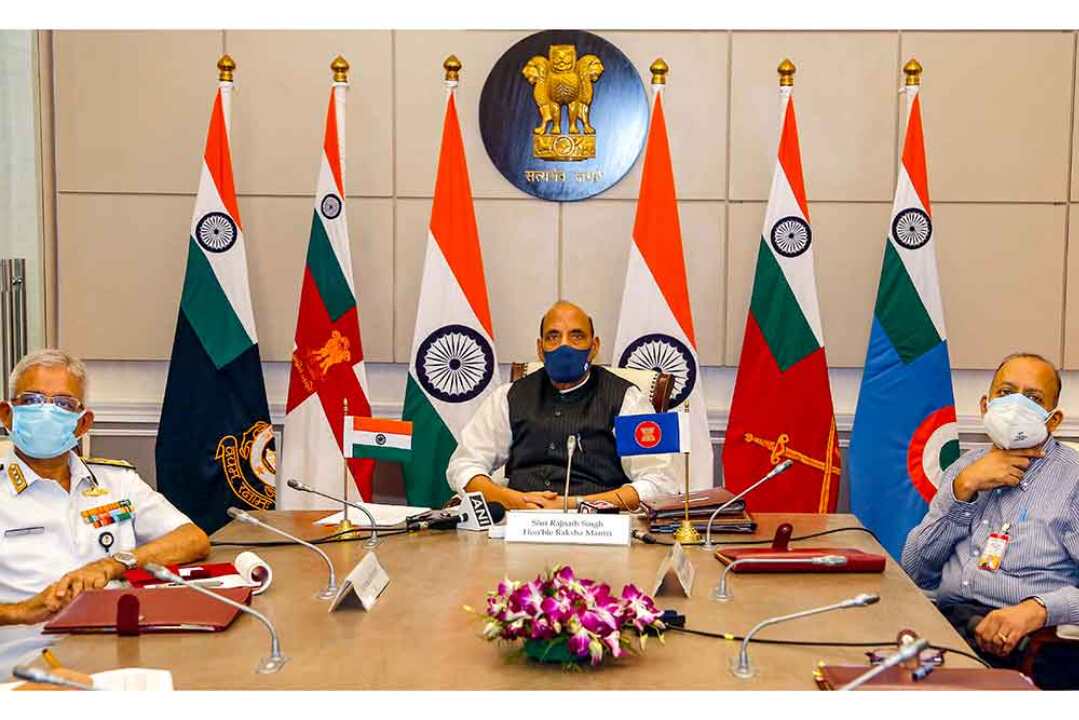Awaiting positive outcome
Apart from highlighting the centrality of ASEAN, India expressed hope for fruitful results of the Code of Conduct negotiations with China

Indo-Pacific remains an area of focus to the world and, recently, the spotlight on this construct came up during the eighth ASEAN Defence Ministers Meeting Plus where India underscored the country's cooperative engagements in the region under its overall vision of the centrality of ASEAN, supporting freedom of navigation, overflight and keeping the sea-lanes of communication open.
Reiterating India's viewpoint, Defence Minister Rajnath Singh, who attended the meeting virtually, emphasised on open and inclusive Indo-Pacific that respects the sovereignty and territorial integrity of nations. "India has strengthened its cooperative engagements in the Indo-Pacific based on converging visions and values for promotion of peace, stability and prosperity in the region. Premised upon the centrality of ASEAN, India supports the utilisation of ASEAN-led mechanisms as important platforms for the implementation of shared vision for the Indo-Pacific." The assembly saw the participation of representatives from the 10 ASEAN countries plus eight dialogue partner countries including China and the United States.
The ADMM Plus is an annual meeting of Defence Ministers of 10 ASEAN (Association of Southeast Asian Nations) countries and eight dialogue partner countries — Australia, China, India, Japan, New Zealand, Republic of Korea, Russia and the United States. Brunei is the Chair of the ADMM Plus forum this year. Four of the eight dialogue partners form the Quad (Australia, India, Japan and the United States).
Established in 2010, the objectives of ADMM Plus are to benefit ASEAN member countries in building capacity to address shared security challenges, while taking cognisance of the differing capacities of various member countries and promoting mutual trust and confidence between defence establishments through dialogue and transparency. In view of transnational security challenges, it aims for the enhancement of regional peace and stability through cooperation in defence and security.
The objective includes contributing to the realisation of an ASEAN Security Community embodying ASEAN's aspiration to achieve peace, stability, democracy and prosperity in the region for its member countries to live at peace with one another and with the world at large. Facilitate the implementation of the Vientiane Action Programme, which calls to build a peaceful, secure and prosperous ASEAN, and to adopt greater outward-looking external relation strategies with friends and dialogue partners.
The ADMM Plus currently focuses on seven areas of practical cooperation, namely maritime security, counter-terrorism, humanitarian assistance and disaster management, peacekeeping operations, military medicine, humanitarian mine action and cybersecurity. Expert Working Groups have been established to facilitate cooperation in these areas
Interestingly, the Defence Minister's reference, hoping the Code of Conduct negotiations underway between China and ASEAN will lead to outcomes keeping with international law, and expecting the final pact would not prejudice the legitimate rights and interests of nations, were not at the discussion table.
Over the years, China consolidated its position in the South China Sea that remains an area of strategic importance. China depends heavily on this space as a bulk of its energy and other supplies pass through these waters. There have been contentious developments with Beijing's assertive behaviour in the region including the creation of artificial islands. India will continue to watch with keen interest the evolution of the Code in the South China Sea, as China remains aggressive in its intent.
For the past two decades, these discussions have been going on after China agreed to the Declaration on the Conduct of Parties in the South China Sea in 2002. This was to lead to negotiations on the Code. As for geography, the South China Sea region is surrounded by China and four member states – the Philippines, Vietnam, Malaysia and Brunei. Parleys on aspects of the implementation guidelines took more time and a single draft for the Code emerged three years ago.
The backdrop to these developments offers another dimension that is the relationship of ASEAN countries with China and the economic engagement that is greater in the case of some member states, especially those whose shores are not lapped by the South China Sea.
The Code according to the schedule should be ready this year. Once ready it would be a framework for rules and standards so that the region could be peaceful and stable. The global health pandemic and resultant disruptions in the world could be a factor in the delay towards arriving at the final contours of the pact.
The Code would have to take into account the Indo-Pacific Outlook, adapted by ASEAN three years ago. Key elements of the Outlook include a perspective of viewing Asia-Pacific and Indian Ocean regions, as a closely integrated and interconnected region and not as contiguous territorial spaces. ASEAN plays a central and strategic role, viewing the Indo-Pacific region as one of dialogue and cooperation instead of rivalry, of development and prosperity for everyone and the importance of the maritime domain and perspective in the evolving regional architecture. There is a convergence between the Outlook and the Indo-Pacific Oceans Initiative in terms of increasing regional cooperation.
Views expressed are personal



